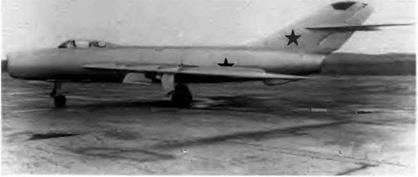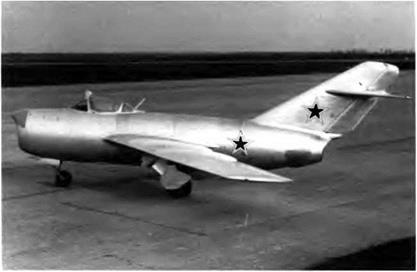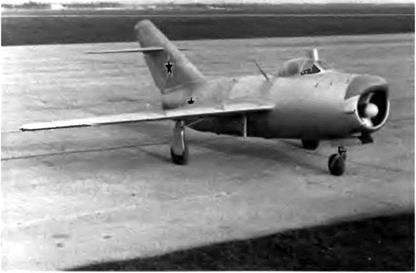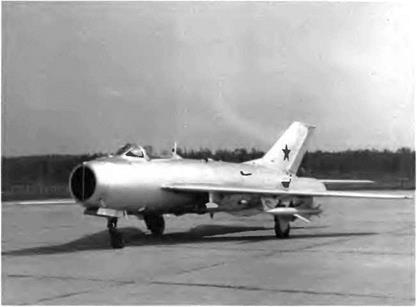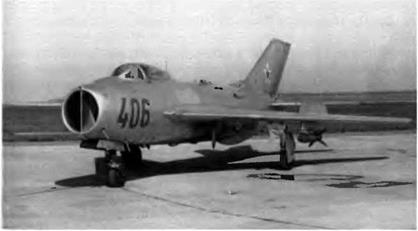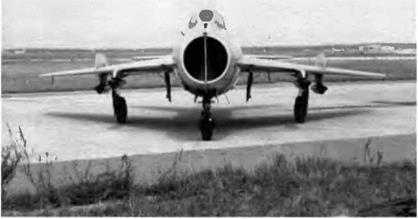The MiG OKB was handed the task of developing the EPOS experimental manned orbit vehicle, a delta-body aircraft, designed within the context of the Spiral space project managed by G. Ye. Lozino-Lozinskiy since 26 June 1966 to observe the handling characteristics and to study the abandon-orbit and landing procedures of the future Soviet space shuttle. The wing, the fin, and the flaps were all set at the rear of the lifting body. The retractable gear had four skid-equipped legs, and the pilot was seated in a pressurized capsule
Seen on a planform view, the lifting body/fuselage revealed a sweepback of 78 degrees at the leading edge. Seen on a sectional view, its upper part was distinctly rounded—but the base was practically flat. The front part of the rounded body, as the site of airflow impact, was rather bulky. The shapes of the lifting body, the wing, and the fin were designed for optimum performance whatever the flight regimes and permissible skin temperatures generated by frictional heating. The
|
The 105-11 was an experimental prototype built to clear the way for the future Soviet space shuttle. Its role was to assess handling, abandon-orbit, and landing procedures.
|
fuselage had sufficient internal space to house all of the systems as well as the necessary test meters.
The fuselage structure was composed of three main parts:
1. The externa] sheet and extruded sections reinforced the articulated heat shield; the latter could lose its shape to any direction, could not generate any thermal stress in uneven heat, and was lined with insulating material
2. The structure itself, composed of tubes and extrusions, withstood all stresses; the shield was attached to this structure, and so were the capsule, power plant, wing, fin, and equipment racks
3. The removable panels included the escape hatch (the inspection holes providing access to the equipment), the access door to the turbojet air intake duct, and the lateral fuselage panels
According to flight regime, the wing panels (55-degree sweepback at the leading edge) could be rotated and set at an angle between 90 and 60 degrees off the vertical. The fin and rudder—area, 1.7 m2 (18.3 square feet); leading edge sweepback, 60 degrees—were attached on the top of the turbojet bay. The airbrakes were hinged on the upper surface of the rear fuselage.
The flying controls (elevons and rudder) were manually operated. The control column and the rudder pedals were of the standard variety. The turbojet was controlled by a throttle lever; the jet reaction control nozzles were electrically controlled by a special lever. The manual controls worked with the automatic controls of the SNAU (automatic navigation and control system) The wings were rotated by an electric engine through a ball-screw actuator. The turbojet’s air intake shutter was controlled by a two-position pneumatic cylinder.
The aircraft’s angle of attack was quite high at landing. The rear skids touched the ground first, before the aircraft tipped forward onto the front skids. The four struts of the gear were fitted with shock absorbers. The front legs retracted into the lateral fuselage panels above the heat shield, while the rear legs retracted into the rear part of the fuselage.
The compressed air necessary to extend or retract the gear and the flaps was stored in the front oleo struts. The cockpit consisted of a pressurized metallic capsule lined with insulating material. The rear part of the pilot’s capsule was protected by a heat shield close to the "emergency exit’’ in the atmosphere. The cockpit’s glass panels offered sufficient outward vision in orbit, on approach, and at landing. The capsule was mounted on two rails anchored in the fuselage structure and had a pyrotechnic ejection device. The pilot could decide to eject at any time during the flight, from takeoff to landing.
The jet reaction control nozzles (GDU) could be used in orbit or in the earth’s atmosphere at supersonic and hypersonic speeds. The nozzles were located at the rear of the fuselage on the sides of the power units and were protected by fairings. Each power unit fed three large nozzles rated for 15.68 daN (16 kg st) and five smaller nozzles for 0.98 daN (1 kg st); there were therefore six large and ten small nozzles in all. Four of the large nozzles, set vertically, controlled the pitch and roll axis just like elevons; the other two, set horizontally, controlled the yaw axis. To provide perfect orbit stabilization, the smaller nozzles were distributed according to the control channels: four in pitch, four in roll, and two in yaw. The nozzles were controlled by electric valves that received signals from the SNAU unit and the lever.
The rocket engine was intended for performing maneuvers in orbit and for braking to abandon orbit With its group of turbopumps, it was rated at 1,470 daN (1,500 kg st). It was located in the rear fuselage, and its thrust force was directed to the aircraft’s center of gravity. It had two auxiliary combustors capable of 39.2 daN (40 kg st) that could be used to brake and abandon orbit in case of main engine failure. The propellant tanks were located in the fuselage’s center section near the aircraft’s center of gravity.
The Kolyesov RD-36-35K turbojet, rated at 1,960 daN (2,000 kg st), was used at takeoff up to Mach 0.8 as well as at landing. A fairing located between the upper part of the fuselage and the base of the fin housed this turbojet. The air intake duct was plugged by a cylinder – operated flap that was opened just before the engine started. The fuel tanks were located in the center section ahead of the center of gravity. All systems were housed in two containers flanking the rear fuselage; for access, one simply removed the containers. Inside there, normal operating conditions were maintained (pressure, 760 mm Hg; temperature, 10-50° C [50-122° F]).
For the first test phase, planned for 1974, the OKB built a full-scale experimental machine. Referred to as the izdeliye 105-11, it was unlike the orbital plane in several respects:
—neither the rocket engine controls nor the jet reaction control nozzles were installed
—the electrical governors of the control nozzles were replaced by the ARS-40 electrohydraulic actuation unit
—for the ground-roll and leapfrog tests, the front skids were replaced by wheels
— the instrument panel was equipped with standard instruments (gyrocompass, altimeter, and the like)
In 1975 the turbojet was revved up on one of TsLAM’s test benches (ignition tests: V = 300 km/h [162 kt], a [angle of attack] = -5°/+ 20°, f> [sideslip angle] = ±5°). Once all of these experiments were carried out successfully, it was time to start the flight-test phase. Between 1976 and 1978 the 105-11 made a series of ground rolls and actually went a few feet into the air, enabling the pilot and the engineers to assess its stability and handling qualities as well as the ground’s effect on its maneuverability.
On 11 October 1976 the MiG test pilot A. G. Festovets took off in the 105-11 (with half-skid/half-wheel gear), climbed to 560 m (1,835 feet), and landed a few minutes later at another airfield 19 km (12 miles) away. After the data was analyzed it was decided to proceed with the basic tests in order to sharpen the approach path for final and landing sequences. On 27 November 1977 the 105-11 with Festovets at the controls was released from a Tupolev Tu-95K bomber at 5,000 m (16,400 feet) and landed on a specially prepared unpaved strip.
The aircraft flew only eight times between November 1977 and September 1978, but this was enough to assess its subsonic flight envelope. After full analysis of the test results, it was decided to proceed with the project. The 105-11 can be seen today in the WS museum on the Monino airfield near Moscow.
Specifications
Wing area, 6.6 m2 (71.04 sq ft); lifting body/fuselage area, 24 mz (258.3 sq ft); empty weight, 3,500 kg (7,715 lb); takeoff weight, 4,220 kg
(9,300 lb); landing weight, 3,700 kg (8,155 lb); fuel + oil, 500 kg (1,100 lb); wing loading, 640 kg/m2 (131.2 lb/sq ft).
Performance
Landing speed, 250-270 km/h (135-146 kt)














